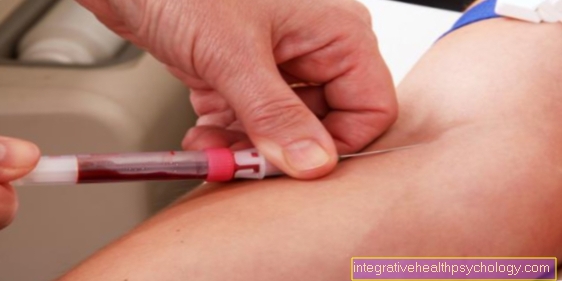Koplik spots
definition
The so-called Koplik spots are changes in the mucous membrane in the area of the cheek as part of a measles infection. It shows itself in the form of circumscribed small reddening with a white center. Colloquially, they are therefore also referred to as "lime splatter stains". Koplik spots only appear in the initial stage of the infection and are replaced as the disease progresses by the typical fine-spotted rash all over the body.

causes
The cause of the appearance of Koplik spots on the cheek area is infection with the measles virus. In most cases, the virus is transmitted via a droplet infection. In the case of children, this means that contact with other sick children in particular poses a high risk of infection.
The lime-splatter-like stains appear at the beginning of the disease and are mostly not noticed either by the person affected or by the parents due to their location in the inner mouth area. This also explains the high risk of infection with the virus in the early stages of infection. This is why it is not uncommon for many children to fall ill at the same time if they are not protected by a vaccination.
Read more on the topic: Red spots on the roof of the mouth, inflammation of the cheek
Koplik spots after vaccination
Koplik spots may appear after vaccination. The measles vaccination is a live vaccination that can cause a so-called "vaccine-induced infection".Simply put, vaccination with the weakened pathogen can trigger a mild form of the actual disease. The "vaccine measles" occur within one to four weeks together with an increased body temperature. As a rule, the vaccination reaction is not dangerous and should be monitored as it progresses.
Read more on the topic:
- MMR vaccination
- Rash After Vaccination - What Causes It?
- Fever in baby after vaccination
Concomitant symptoms
Measles infection is a generalized viral disease. This means that it affects the entire body. Children therefore often show an increased body temperature at the beginning of the illness, which is accompanied by a general feeling of illness. Swollen lymph nodes in the neck area are also possible.
It is not uncommon for the initial stage to resemble a cold. An important differentiator to this, however, is the two-phase fever. Affected children therefore feverishly for a short time and then are free of fever for a short time and then feverish again. In the first bout of fever, the Koplik spots appear and in the second the typical fine-spotted rash all over the body.
Read more on the topic:
- Fever suppositories (for babies and children)
- How can you lower a fever?
- Skin rash in children - what is the underlying disease?
Koplik spots and pain
Most children do not even notice Koplik spots. Rather, they suffer from the increased body temperature and feel weak as a result. However, if there is an additional infection of the mucous membrane with bacteria, Koplik spots can also be painful. Mostly it is more of a burning sensation on the mucous membrane that the children describe. The sensation can be explained by the fact that the surface of the mucous membrane is attacked by the pathogen and reactively leads to the body's own defense reaction. This then manifests itself in an inflammatory reaction, which can lead to pain with local reddening.
Read more on the topic: Aphthae - painful blisters in the mouth and throat, burning in the mouth
Koplik spots on the tongue
It is characteristic of Koplik's spots that they appear on the cheek area. If there is small redness with a white center on the tongue, in most cases it is not a phenomenon of measles infection. Especially if the changes observed on the tongue are very painful, it is more of a fungal infection of the tongue mucosa. In the course of the process, the spots then turn into a flat reddening with whitish areas.
Read more on the topic: Oral thrush, oral thrush in babies
Treatment / therapy
Treatment of an infection with measles is purely symptomatic. This means that all drugs used only relieve the symptoms of the infection. The pathogen itself is not directly influenced by this therapeutic measure. Rather, it is the job of the body's immune system to fight the virus successfully.
However, so that the body's own healing can be optimally supported, fever-lowering agents are often prescribed if necessary. However, these should not be used when the fever is low, but only when the child expresses a clear level of suffering. The increased body temperature is part of the defense reaction that is needed for increased metabolic processes. As a rule, this level of suffering can be observed in a clear listlessness, as well as declining drinking and eating. Then so-called antipyretics should be given. Paracetamol is common for children under four years of age and ibuprofen for older children.
Read more on the topic: Fever suppositories
If there is also pain in the mucous membrane due to the Koplik spots, this can be alleviated with a local anesthetic. This is usually prescribed in the form of a tincture that can be brushed onto the affected areas before eating. However, it is rare that this measure is necessary in the context of a measles infection. Rather, it helps to stabilize the child's general condition. Simple measures like a mild bed rest and adequate hydration are therefore most important.
Duration
The duration of illness with measles can be up to three weeks. Koplik spots only appear at the beginning of the disease and regress within a few days. They are usually not available for more than three days. The typical fine-spotted rash is rather an indicator of the duration of the illness. When the rash has completely disappeared, the viral infection is usually over. Due to the high risk of infection with measles, it is advisable to wait a few days before the child can go to kindergarten or school again. In addition, the child must be safely free of fever.
Read more on the topic: Is my rash contagious?





























